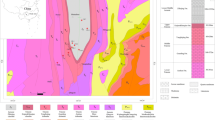Abstract
According to Alexander and Cady (1962), laterite is a highly weathered material rich in secondary oxides of iron, aluminum, or both. It is nearly void of bases and primary silicates, but it may contain large amounts of quartz and kaolinite. It is either hard or capable of hardening upon exposure to wetting and drying. This general definition is based on the original work of Buchanan (1807), modified by the work of many others since then. However, the term laterite is perhaps one of the most misused terms in earth sciences. Many inconsistencies and confusion exist in the literature about the term laterite and the process of laterization. The term has been adopted by geologists, mineralogists, mining engineers, and pedologists, and today it encompasses materials that show some kind of sesquioxide accumulation and ranges from weathered rock to hard and cemented ironstone. Further complication was introduced in tropical soils literature, when terms such as laterite profile and lateritic soils were introduced. Due to this confusion in soils literature, Kellogg (1949) introduced the term latosol—LAT derived from laterite—to distinguish them from laterites, but later Maignien (1966) proposed to abandon the term laterite. The reader is referred to this excellent review by Maignien (1966) for information on the early work.
Access this chapter
Tax calculation will be finalised at checkout
Purchases are for personal use only
Preview
Unable to display preview. Download preview PDF.
Similar content being viewed by others
References
Alexander, L.T., and J.G. Cady. 1962. Genesis and hardening of laterite in soils. Tech. Bull. 1282, Soil Conservation Service, U.S. Dept. Agric.
Blume, L.J., H.F. Perkins, and R.K. Hubbard. 1987. Subsurface water movement in an Upland Coastal Plain soil as influenced by plinthite. Soil Sci. Soc. Am. J. 51:774–779.
Brummer, G. 1973. Redox reaktionen als merkmalspragende Prozesse hydromorpher boden. pp. 17–28. In: E. Schlichting and U. Schwertmann (eds.), Pseudogley andgley. Verlag Chemie, Weinheim, West Germany.
Buchanan, F. 1807. A journey from Madras through the countries of Mysore, Canara and Malabar. East India Co., London, 2:440–441.
Chadwick, F., and D. Nettleton. 1988. Micromorphologic evidence of adhesive and cohesive forces in soil cementation. In: Press. Proc. Int. Work. Meet. Soil Micromorphology, San Antonio, Texas.
Chariot, G. 1966. Les methodes de la chimie analytique. Masson et Cie, Paris.
Daniels, R.B., H.F. Perkins, B.F. Hajek, and E.E. Gamble. 1978. Morphology of discontinuous phase plinthite and criteria for its field identification in the Southeastern United States. Soil Sci. Soc. Am. J. 42:944–949.
De Coninck, F. 1980. Major mechanisms in formation of spodic horizons. Geoderma 24:101–128.
Eswaran, H., J. Comerma, and V. Sooryanarayanan. 1980. Scanning electron microcopic observations on the nature and distribution of iron minerals in plinthite and petroplinthite. pp. 335–341. Lateritisation Processes, Proc. Int. Sem. Laterisation Processes. Oxford and IBH Publishing Co., New Delhi.
Eswaran, H., and N.G. Raghumohan. 1973. The microfabric of petroplinthite. Soil Sci. Soc. Am. Proc. 37:79–81.
FAO. 1976, 1978, 1979. Soil map of the world. Vol. VI, Africa (1976); Vol. VII, South Asia (1978); Vol. IX, South East Asia (1979). FAO-UNESCO, Rome.
Gallaher, R.N., H.F. Perkins, and K.H. Tan. 1974. Classification, composition, and mineralogy of iron glaebules in a Southern Coastal Plain soil. Soil Sci. 117:155–164.
Guthrie, R.L., and B.F. Hajek. 1979. Morphology and water regime of a Dothan soil. Soil Sci. Soc. Am. J. 43:142–144.
Hem, J.D., and C.E. Roberson. 1967. Form and stability of aluminum hydroxide complexes in dilute solution. Geol. Survey, Water Supply Paper 1827. U.S. Govt. Printing Office, Washington, D.C.
Herbillon, A.J., and D. Nahon. 1985. Laterites and laterization processes, pp. 779–796. In: J.W. Stucki, B.A. Goodman, and U. Schwertmann (eds). Iron in soils and clay minerals. NATO ASI Series, D. Reidel Publishing Co., Dordrecht, Netherlands.
Kellogg, C.E. 1949. Preliminary suggestions for the classification and nonmenclature of great soil groups in tropical and equatorial regions. Commonwealth Bureau Soil Sci., Tech Commun. 46:76–85.
Krauskopf, K.B. 1967. Introduction to geochemistry. McGraw-Hill, NY.
Maignien, R. 1966. Review of research on laterites. UNESCO, Paris.
Millot, G. 1964. Geologie des argiles. Masson & Cie, Paris.
Ottow, J.C.G. 1973. Bacterial mechanisms of iron reduction and gley formation, pp. 29–36. In: E. Schlichting and U. Schwertmann (eds.), Pseudogley and gley. Verlag Chemie, Weinheim, West Germany.
Sanderson, R.T. 1964. Chemical periodicity. Reinhold, NY.
Schwertmann, U. 1985. Some properties of soil and synthetic iron oxides, pp. 203–204. In: J.W. Stucki, B.A. Goodman, and U. Schwertmann (eds.), Iron in soils and clay minerals. NATO ASI Series, D. Reidel Publishing Co., Dordrecht, Netherlands.
Soil Survey Staff. 1975. Soil taxonomy: A basic system of soil classification for making and interpreting soil surveys. U.S. Dept. Agric. Handbook 436, U.S. Govt. Printing Office, Washington, DC.
Stoops, G. 1970. Scanning electron microscope applied to the micromorphological study of laterite. Pedologie 20:268–280.
Sys, C. 1968. Suggestions for the classification of tropical soils with lateritic materials in the American classification. Pedologie 18:189–198.
Van Schuylenborgh, J. 1973. Sesquioxide formation and transformation, pp. 93–103. In: E. Schlichting and U. Schwertmann (eds.), Pseudogley and Gley. Verlag Chemie, Weinheim, West Germany.
Wood, B.W., and H.F. Perkins. 1976. Plinthite characterization in selected Southern Coastal Plain soils. Soil Sci. Soc. Am. J. 40:143–146.
Author information
Authors and Affiliations
Editor information
Editors and Affiliations
Rights and permissions
Copyright information
© 1990 Springer-Verlag New York Inc.
About this chapter
Cite this chapter
Eswaran, H., De Coninck, F., Varghese, T. (1990). Role of Plinthite and Related Forms in Soil Degradation. In: Lal, R., Stewart, B.A. (eds) Advances in Soil Science. Advances in Soil Science, vol 11. Springer, New York, NY. https://doi.org/10.1007/978-1-4612-3322-0_3
Download citation
DOI: https://doi.org/10.1007/978-1-4612-3322-0_3
Publisher Name: Springer, New York, NY
Print ISBN: 978-1-4612-7966-2
Online ISBN: 978-1-4612-3322-0
eBook Packages: Springer Book Archive




